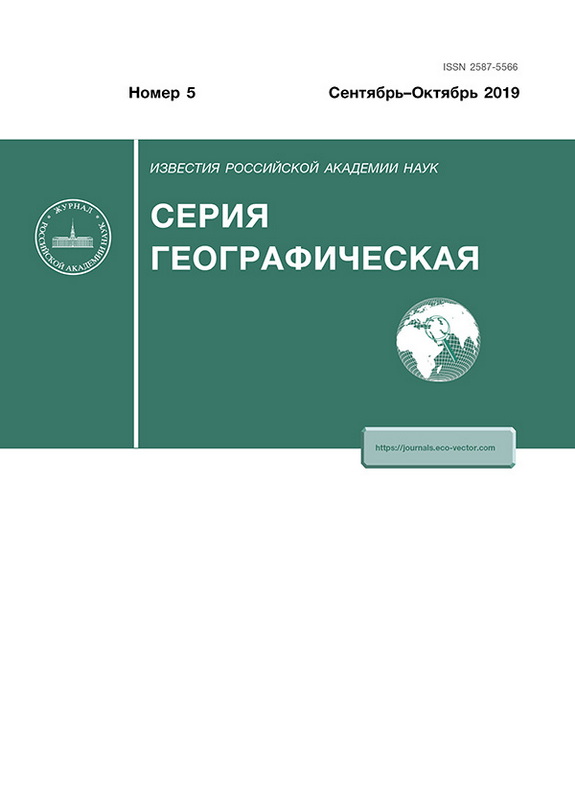People and money: incomes, consumption and financial behavior of the population of the Russian regions in 2000–2017
- Authors: Zubarevich N.V.1,2, Safronov S.G.1
-
Affiliations:
- Lomonosov Moscow State University
- National Research University Higher School of Economics, Institute for Social Policy
- Issue: No 5 (2019)
- Pages: 3-17
- Section: РЕГИОНАЛЬНЫЕ ГЕОГРАФИЧЕСКИЕ ПРОБЛЕМЫ
- URL: https://journals.eco-vector.com/2587-5566/article/view/17577
- DOI: https://doi.org/10.31857/S2587-5566201953-17
- ID: 17577
Cite item
Abstract
Macroeconomic dynamics affects incomes of regions’ population and level of poverty: positive shifts in the distribution of regions in relation to these indicators slowed down in the 2010s and were replaced by a negative shift (more apparent in poverty rate) during the crisis of 2014–2017. Income dynamics had a stronger effect on consumption structure and less on population financial behavior. The share of food expenditures is declined in all regions until the 2014 crisis; the most developed regions have the lowest percentage. Structural shift in expenditures in favor of durable goods, including housing, is far from complete in most regions. The increase in the share of expenditures for services is largely due to the growth of tariffs for public utility services. Regional differences are small, with the exception of the Far North regions. The share of spending on human capital reproduction is low and varies slightly between regions. The population of “rich” regions prefers to spend money on recreation and entertainment, but these expenses are shrunken during the last crisis. Individuals' savings behavior is mostly developed in the largest federal cities. Overdue loans are higher in underdeveloped republics and in resource-producing regions, whose population seeks to maintain the level of consumption using loans. The main factor in change structure of consumption and financial behavior is the population incomes, but demographic, settlement and institutional factors must be considered to explain regional differences.
Full Text
About the authors
N. V. Zubarevich
Lomonosov Moscow State University; National Research University Higher School of Economics, Institute for Social Policy
Author for correspondence.
Email: nzubarevich@gmail.com
Faculty of Geography
Russian Federation, MoscowS. G. Safronov
Lomonosov Moscow State University
Email: saffff@mail.ru
Faculty of Geography
Russian Federation, MoscowReferences
- Burdyak A., Grishina E. The standard of living of the population: incomes, wages, loans in the regions. Ekonomicheskoe Razvitie Rossii, 2018, vol. 25, no. 1, pp. 53–57. (In Russ.).
- Dokhody, raskhody i potreblenie domashnikh khozyaistv v 2017 godu [Incomes, Expenses and Consumption of Households in 2017]. Moscow: Rosstat, 2018. 148 p.
- Zubarevich N.V. Sotsial`noe razvitie regionov Rossii: problemy` i tendentsii perekhodnogo perioda [Social Development of Russian Regions: Problems and Transition Trends]. Moscow: Editorial URSS Publ., 2003. 264 p.
- Zubarevich N.V. Regiony Rossii: neravenstvo, krizis, modernizatsiya [Regions of Russia: Inequality, Crisis, Modernization]. Moscow: Nezavisimyi Inst. Sotsial’noi Politiki, 2010. 160 p.
- Zubarevich N.V., Safronov S.G. Share of food expenses in the total expenditures of population in Russian regions as indicator of standart of livingand consumption modernization. Vestn. Mosk. Univ., Ser. 5: Geogr., 2019, no. 2, pp. 61–68. (In Russ.).
- Zubarevich N., Khasanova R., Florinskaya Yu. The social situation and the demographic situation in the regions in the first half of 2018. Ekon. Razvitie Rossii, 2018, vol. 25, no. 9, pp. 75–88. (In Russ.).
- Ibragimova D.Kh. Savings behaviour of Russians in 2009-2013. Bankovskoe Delo, 2013, no. 12, pp. 48–53. (In Russ.).
- Ibragimova D.Kh., Kuzina O.E. Current accounts and deposits of Russian households: volumes, structure and distribution. Bankovskoe Delo, 2014, no. 12, pp. 28–35. (In Russ.).
- Kornekova S.Yu. Geografiya prodovol’stvennogo potrebleniya: sistemnyi analiz [Food Consumption Geography: System Analysis]. St. Petersburg: S.-Peterb. Gos. Ekon. Univ., 2017. 242 p.
- Korchagina I.I. Incomes and consumption of the population in the regional dimension. In Prostranstvennaya demografiya i sotsial'naya sreda [Spatial Demography and Social Environment]. Moscow: M-Studio Publ., 2012, pp. 196–236. (In Russ.).
- Kuzina O.E. Analysis of the dynamics of using bank loans and the debt burden of Russians. Den’gi i Kredit, 2013, no. 11, pp. 30–36.
- Kuzina O.E., Krupenskiy N.A. Over-indebtedness of Russians: myth or reality? Vopr. Ekonomiki, 2018, no. 11, pp. 85–104. (In Russ.).
- Maleva T.M., Grishina E.E., Tsatsura E.A. Sotsial’naya politika v dolgosrochnoi perspektive: mnogomernaya bednost’ i effektivnaya adresnost` [Social Policy in the Long Term: Multidimensional Poverty and Effective Targeting]. Moscow: Delo Publ., 2019. 52 p.
- Neformal'nye platezhi za meditsinskuyu pomoshch' v Rossii [Informal Payments for Medical Care in Russia]. Shishkin S.V., Ed. Moscow: Mosk. Obshchestv. Nauchn. Fond, Nezavisimyi Inst. Sotsial`noi Politiki, 2003. 160 p.
- Ovcharova L.N., Biryukova S.S., Ter-Akopov S.A., Vardanyan E.G. Chto izmenilos` v dokhodakh, raskhodakh i potreblenii naseleniya? [What has Changed in Income, Expenditure and Consumption of the Population?]. Moscow: NIU Vyssh. Shkola Ekonomiki, 2014. 42 p.
- Ovcharova L.N., Popova D.O. Incomes and expenses of Russian households: What has changed in the mass standard of consumption. Mir Rossii, 2013, no. 3, pp. 3–34. (In Russ.).
- Working Towards a Poverty Eradication Strategy in Russia: Analysis and Recommendations, Ovcharova L.N., Ed. ILO, 2001. 214 p.
- Regional`nye osobennosti urovnya i kachestva zhizni [Regional Features of the Level and Quality of Life]. Rimashevskaya N.M., Ed. Moscow: ISEPN RAN, 2012. 391 p.
- Rossiya regionov: v kakom sotsial`nom prostranstve my zhivem? [Russian Regions: What Social Space do We Live In?]. Moscow: Pomatur Publ., 2015. 277 p.
- Rudenko D.Yu. Strategiya sokrashcheniya bednosti v regione [Poverty Eradication Strategy in the Region]. Tyumen: OLMARPRESS, 2011. 223 p.
- Sotsial’nye itogi i uroki dlya ekonomicheskoi politiki [Social Outcomes and Lessons for Economic Policy]. Maleva T.M., Ed. Moscow: Delo Publ., 2018. 122 p.
- Burdyak A.Ya., Polyakova A.G., Loginov D.M., Maleva T.M. Current trends in social development. In Ekonomicheskoe razvitie Rossii [Economic Development of Russia]. Moscow, 2017, pp. 86–95. (In Russ.).
- Yemtsov R. Quo vadis? Inequality and poverty dynamics across Russian regions. In Spatial Inequality and Development. Kanbur R., Venables A.J., Eds. Oxford: Oxford Univ. Press, 2003, pp. 348–408.
Supplementary files














